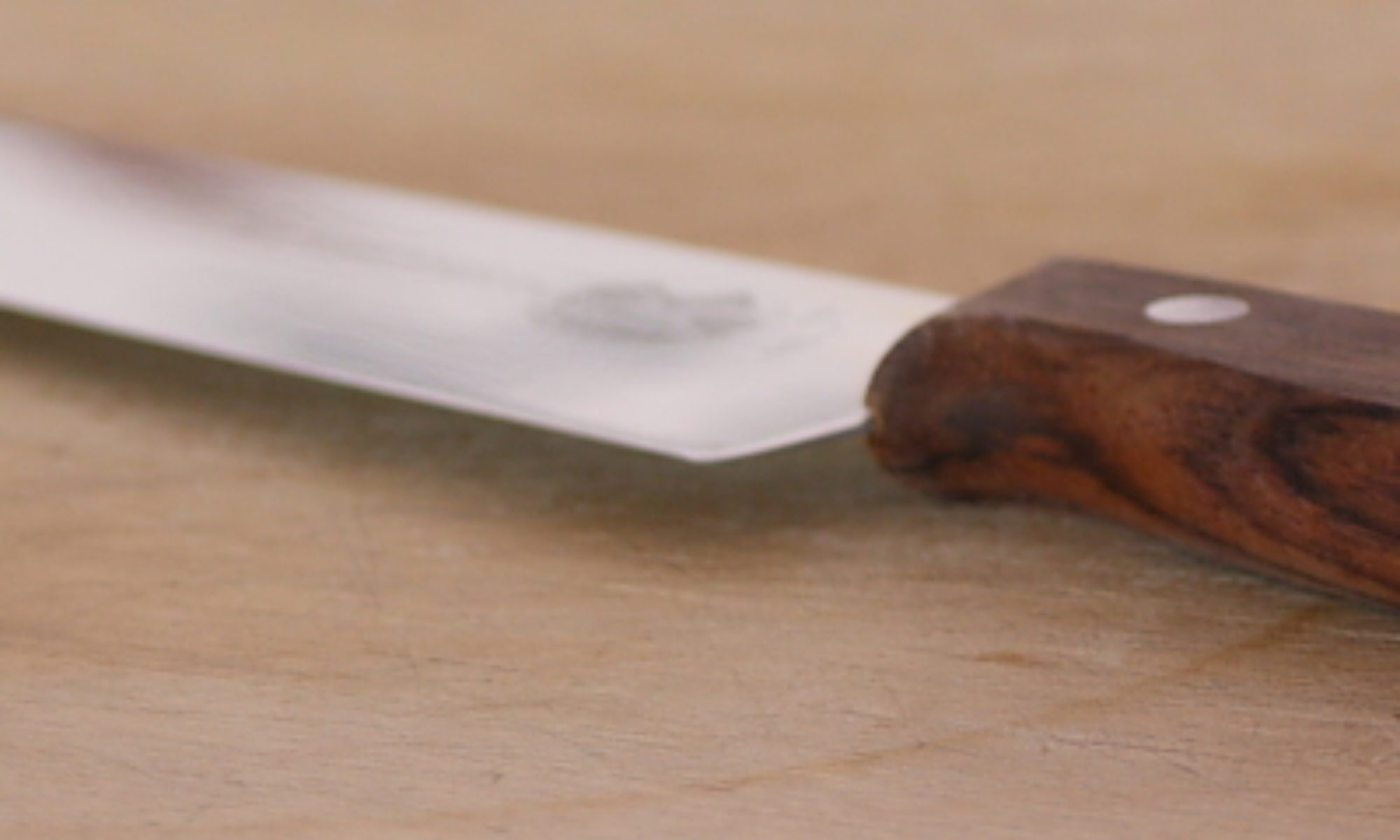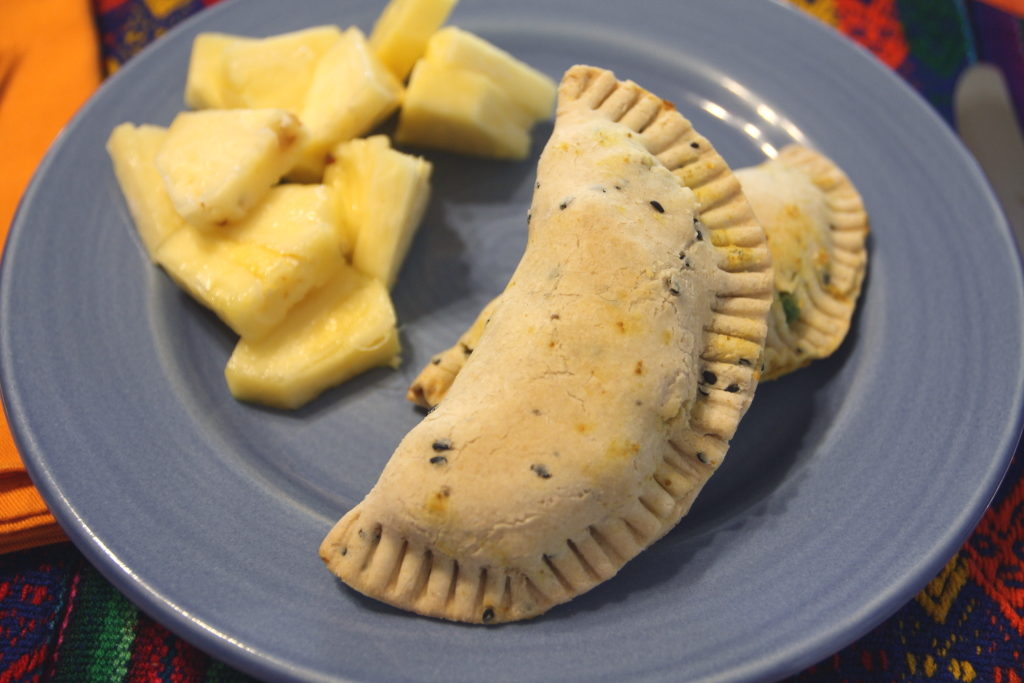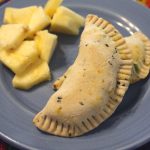
Often, when we go out to dinner at an Indian restaurant, we order a sampler appetizer, consisting of pakoras, samosas, and the like. Sometimes we like these even better than the meal; not surprisingly, because they’re usually deep-fried. Well, we don’t deep-fry here in the Scratchin’ It Kitchen, mainly because of dealing with all that oil, so, we figured, why not bake samosas instead?
Yes, why not? Sure, the crust might be a bit drier (and less oily), but we figured they’d be better for us, and we could stuff them with our choice of fillings. Besides, we have an ulterior motive — we’re trying to do more savory treats. Everyone does sweet things, and they’re good, but something savory, well, that might just hit the spot from time to time. Oh, we know that we’ll still make a few sweets, but it’s fun to mix up things, too.
For the samosa dough, we started with a recipe on Veg Recipes of India, and modified it somewhat. For the filling, we simply modified our recipe for Khumbi Matar.
Potato and Pea Somosas
Ingredients
For the crust
- 2 cups all-purpose flour (280 g)
- 1/2 tsp salt
- 1 tsp black sesame seeds optional
- 1/4 tsp celery seeds optional
- 4 Tbs cold unsalted butter, cut into 8 pieces (57 g)
- 5-6 Tbs water
For the filling
- 2 medium potatoes peeled and diced into 1/2 inch cubes
- Salt
- 1 1/2 tsp ground coriander
- 1 tsp ground cumin
- 1/4 tsp turmeric
- 1/8 tsp cayenne or to taste
- 1 tsp ground ginger
- 2 Tbs vegetable oil
- 1/4 cup minced onions
- 6 ounces frozen peas
Instructions
For the crust
- In a medium bowl, stir together flour, salt, sesame seeds, and celery seeds.
- Add butter, and, working quickly with your fingers, cut the butter into the flour mixture until it resembles a coarse cornmeal.
- Add water, about a tablespoon at a time, and work in until it forms a dough that sticks together.
- Turn out onto a clean work surface and knead about 30 times. Wrap in plastic and let rest for 30 to 40 minutes.
For the filling
- Place potatoes in a medium saucepan and cover with cold salted water. Place over medium-high heat and bring to a low boil. Reduce heat to a simmer and cook until potatoes are tender, about 10 minutes. Drain completely.
- Meanwhile, in a small bowl, mix together coriander, cumin, turmeric, cayenne, and ginger with about 1 tablespoon of water to form a paste. Set aside.
- Heat oil in a large skillet over medium heat. When hot, add onions and cook for 3 minutes. Add spice mixture, and stir and cook for about a minute. Add about 1/4 cup of water and cook, scraping the bottom of the pan to loosen the spices that have stuck.
- Add peas and potatoes, stir to coat, and heat through. Taste and add salt as needed.
For assembly
- Roll dough into a rough rectangle about 20x12 inches and 1/8 inch thick. Use a large cutter or the lid of a small saucepan to cut 4-inch diameter circles.
- Place 2 Tbs of filling in the center of each circle, brush water around the edge, fold over, and seal closed, using a fork to crimp. Place on a baking sheet about 2 inches apart.
- If you wish, you can place the samosas closer together and freeze for an hour, then transfer to a plastic bag for longer-term storage in the freezer. Bake from frozen as below, but increasing the time by 10 to 15 minutes.
- The dough can be re-rolled once or twice.
- Preheat oven to 350°F.
- Bake until crusts are brown and everything is heated through 30 to 40 minutes.
Ingredient discussion:
The original crust recipe called for ghee, or clarified butter, but we didn’t have any, nor did we want to spend the time making it, so we just used butter. Unsalted, of course — no sense in having someone else add salt to our foods. The celery seeds and sesame seeds are there for color and visual interest; the original crust called for ajwain seeds. Watch out for the cayenne pepper in the filling; it can be really hot, so start with a small amount. You can always add more when you finish making the filling and are adjusting the seasoning.
Procedure in detail:
For the crust:
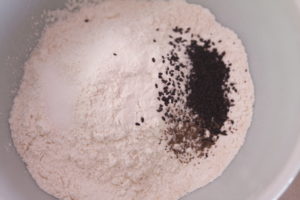
Mix dry ingredients. In a medium bowl, stir together the flour, salt, sesame seeds, and celery seeds. For our crust, we used half white whole-wheat flour and half all-purpose flour. You can do the same, or you can just use all-purpose.
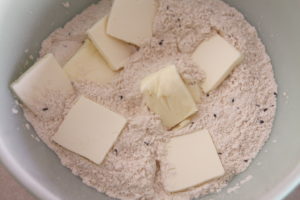
Cut in butter. Add the pieces of butter, and, working quickly, rub and crush the butter into the flour mixture. You don’t want the butter to melt from the heat of your hands; if it does, the crust won’t be flaky, and will be tougher than it would be otherwise. It’ll still taste good, though.
Add water. Add the water about a tablespoon at a time, and use your fingers to work it in after each addition. After about 5 tablespoons, the dough will start sticking together; once it does, turn it out onto a clean work surface for kneading.
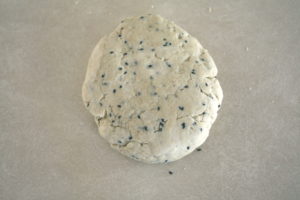
Knead. Knead the dough about 30 times until it comes together and smooths out. If needed, sprinkle a bit more water in spots to incorporate all the flour mixture.
Rest. Wrap the dough in plastic and let rest for 30-40 minutes. If you want to hold off rolling longer than that, place it in the refrigerator for up to 24 hours.
For the filling:
Cook potatoes. Put the potato pieces in a medium saucepan, cover with cold salted water, place over medium-high heat, and bring to a low boil. Reduce the heat and continue to simmer until the potatoes are tender, about 10 minutes. Drain completely.
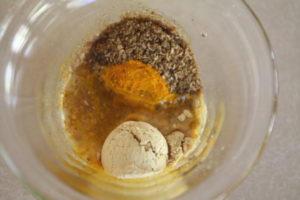
Make spice paste. In a small bowl, stir together the coriander, cumin, turmeric, cayenne, and ginger with about a tablespoon of water to form a spice paste. Set aside for now.
Cook onions. Heat the oil in a large skillet over medium heat. When hot, add the onions, sprinkle with salt, if desired, and cook, stirring occasionally, for 3 minutes.
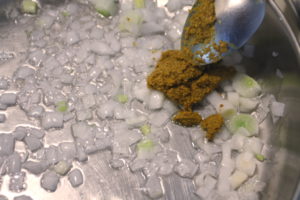
Add spices. Stir in the spice paste and cook, stirring all the while, for about a minute more. Add about 1/4 cup of water, stir and scrape the bottom of the pan to loosen and spices and form a sauce. Reduce heat to medium-low.
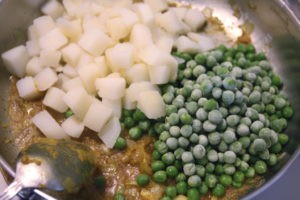
Add peas and potatoes. Stir in the peas and potatoes and cook on low until heated through.
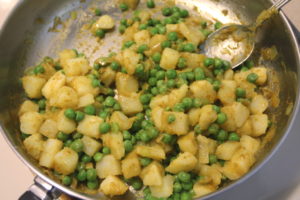
Season. Taste and add salt to taste. If you want to make a spicier samosa, add more cayenne to taste.
For assembly:
Roll out crust. Place the crust on a lightly floured work surface and roll into a large rectangle, about 12 by 20 inches and 1/8 inch thick.
Cut circles. We don’t have a round cutter 4 inches in diameter, so we got inventive and used the lid from a saucepan to cut out round circles. Failing that, you could always cut rectangles and use those as your samosa crusts. It’ll look different but taste the same, of course.
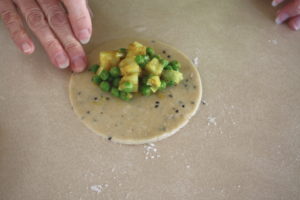
Fill and crimp. Place about 2 tablespoons of the filling in the center of each circle. Dip your finger in water and run it around the edge of the dough. Fold over and press the dough to seal; use a fork to crimp the edges closed. Place on a baking sheet about 2-3 inches apart
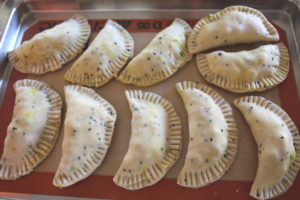
Freeze (optional). If you want to make these in advance, you can place the samosas closer together — not touching — on a baking sheet. Transfer to the freezer for an hour before placing the samosas in a plastic bag and freezing. Bake from frozen, using the directions below, but allowing about 10 minutes more baking time.
Preheat oven to 350°F.
Bake. Slide the samosas into the oven and bake 30 to 40 minutes, turning from front to back halfway through, or until crust is browned and the filling is heated through. If you wish, you can flip the samosas over to ensure an even baking, too. Serve immediately.
Careful when you bite into these samosas as the filling will be hot! Very hot! The potatoes, with all their moisture, really hold in the heat. We served these with Pineapple Chutney, and, while not necessarily as good as some of the deep-fried samosas that we’ve had in the past, these were quite credible for something you make at home. The only thing we might do in the future is brush the samosas with melted butter or vegetable oil right before baking — the crust would have been better if it crisped up more on the outside. An easy four stars.
